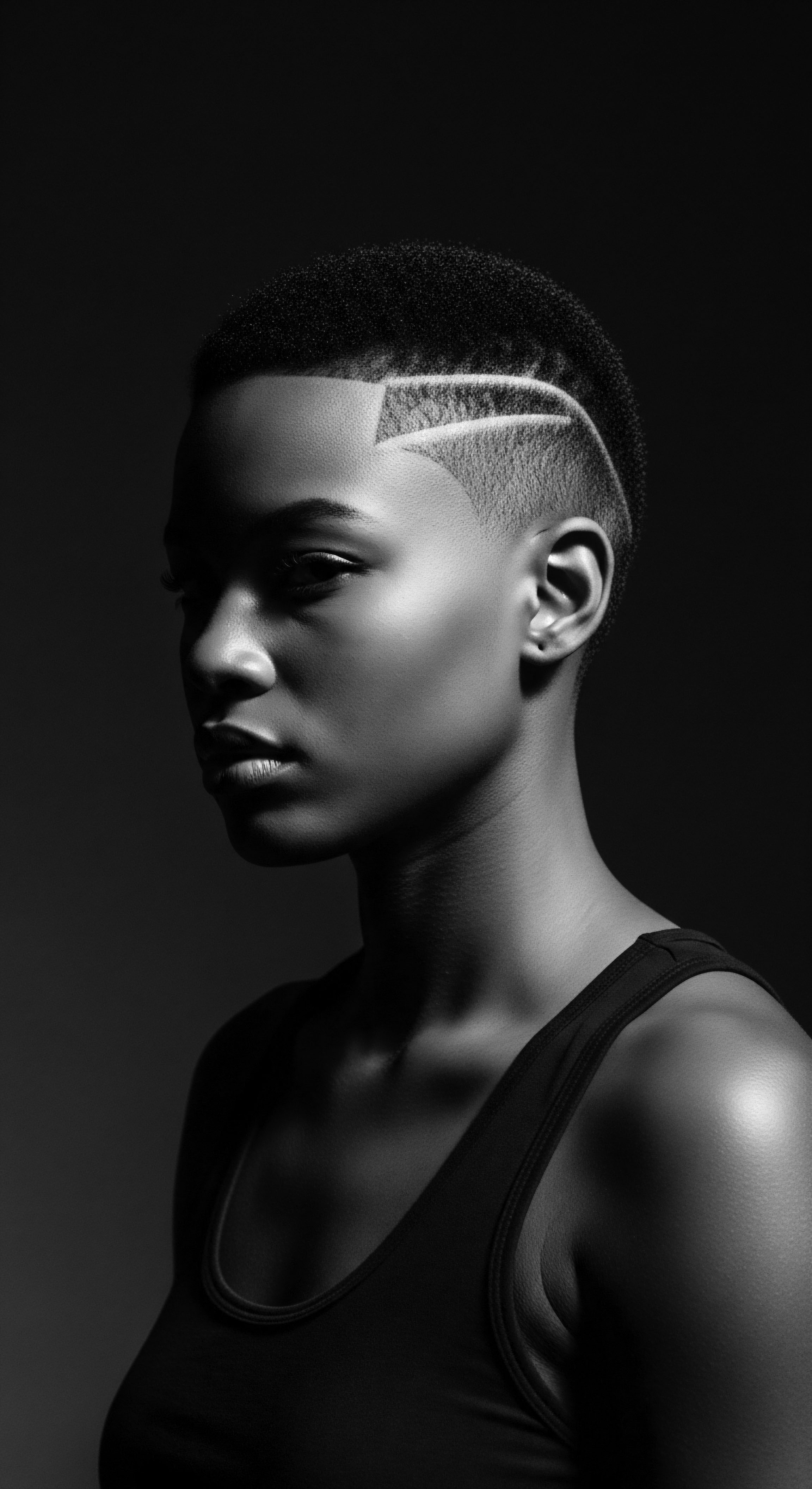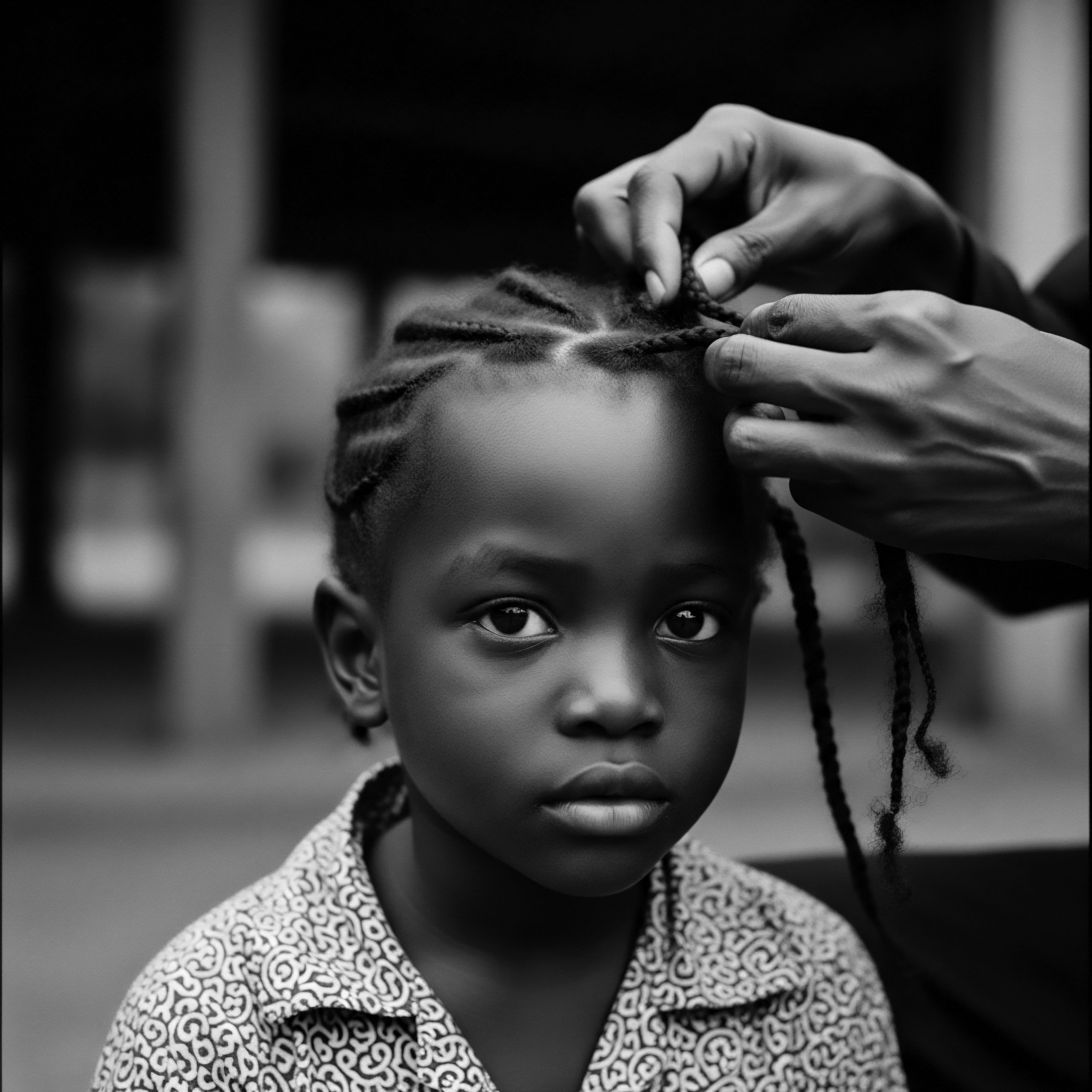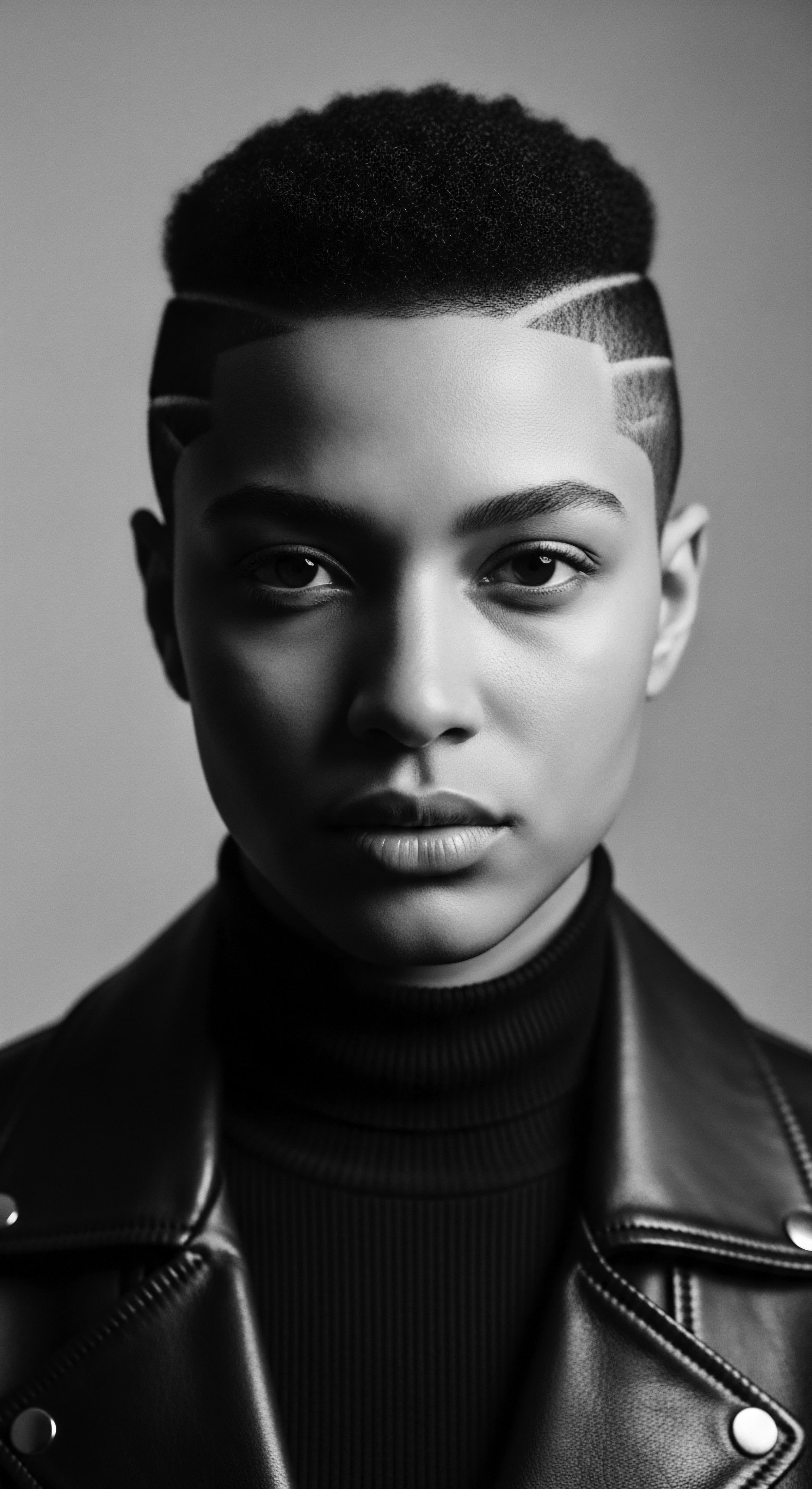
Fundamentals
Within Roothea’s ‘living library,’ the concept of Deep Conditioning stands as a cornerstone, a profound declaration of care for the inherent strength and beauty of textured hair. Its elemental Meaning extends beyond mere hydration; it is an act of restoration, a replenishing ritual that penetrates the very core of each strand. This practice involves applying a specialized, nutrient-rich formulation designed to remain on the hair for an extended period, allowing its beneficial compounds to journey past the outer cuticle and immerse themselves within the inner cortex. The primary Designation of this process centers on fortifying the hair from within, addressing concerns such as dryness, brittleness, and susceptibility to breakage, which are common experiences for curls, coils, and waves.
The historical echoes of Deep Conditioning resonate deeply within ancestral hair traditions, long predating contemporary product labels. Indigenous communities across the globe, particularly those with hair textures celebrated for their resilience and intricate patterns, understood the profound need for sustained nourishment. These early forms of intensive hair care were not merely cosmetic applications; they were acts of reverence, imbued with cultural Significance and often linked to spiritual well-being. From the earthen vessels where natural butters and oils were rendered, to the communal spaces where generations shared wisdom on their application, the principles of deep, lasting hair replenishment were well-established.
Consider the practices observed among various African communities, where the consistent application of rich, unrefined plant oils and butters was a foundational element of hair health. These substances, often derived from local flora, possessed a remarkable affinity for the hair’s structure. The sustained presence of these emollients on the hair allowed for a slow, deliberate absorption, mimicking the deep penetration sought in modern formulations. The Clarification here is that while the terminology might be new, the underlying wisdom of providing sustained, profound nourishment to hair is as old as the traditions themselves.
The hair strand itself, a complex biological marvel, comprises layers that speak to its needs. The outermost layer, the Cuticle, resembles protective scales, while beneath lies the Cortex, a fibrous core giving hair its strength and elasticity. Regular conditioners primarily smooth the cuticle, offering temporary surface benefits.
Deep conditioners, by their very Intention, are formulated with smaller molecular structures and potent active ingredients that can navigate past these cuticular scales, reaching the cortex to deposit vital proteins, lipids, and humectants. This targeted delivery helps to rebuild compromised areas, restore internal moisture balance, and improve the hair’s overall structural integrity.
Deep Conditioning, at its heart, is an ancient wisdom refined, a continuous thread of care connecting ancestral practices to modern hair science for profound strand replenishment.
The fundamental Elucidation of Deep Conditioning for textured hair begins with recognizing its unique structural characteristics. The natural curvature of coils and curls creates points along the strand where the cuticle may be naturally raised, making it more vulnerable to moisture loss and external damage. These areas benefit immensely from the prolonged contact with fortifying ingredients, allowing them to absorb more deeply and provide sustained protection. This understanding informs the composition of these treatments, which often contain a higher concentration of restorative agents than daily conditioners.
Ancestral hair care traditions often involved ingredients applied with intent, often over extended periods, providing profound benefits that resonate with the modern understanding of deep conditioning.
- Shea Butter ❉ Revered across West Africa, often melted and applied to hair and scalp, left for hours or days, providing intense moisture and sealing properties.
- Coconut Oil ❉ A staple in many tropical regions, its smaller molecular structure allowed for deeper penetration into the hair shaft, a traditional remedy for dryness and brittleness.
- Aloe Vera ❉ Used for its soothing and hydrating properties, applied as a gel or paste to hair, often left on to provide lasting moisture.
- Clay Masks ❉ Certain clays, like Rhassoul clay from Morocco, were mixed with water or oils and applied to hair, offering gentle cleansing while also conditioning and softening.
The continuity of this deep care, from ancient practices to contemporary formulations, underscores the enduring human desire to honor and preserve the vitality of hair, particularly for those whose strands carry the stories of resilience and heritage.

Intermediate
Moving beyond the foundational understanding, the intermediate Description of Deep Conditioning reveals a sophisticated interplay between historical practice and scientific refinement. This practice is not merely about adding moisture; it is a strategic intervention designed to address the specific vulnerabilities inherent in the architecture of textured hair. The spiraling nature of curls and coils means that natural oils produced by the scalp struggle to travel down the entire length of the hair shaft, leaving the ends particularly susceptible to dryness and breakage. Deep conditioners counteract this by delivering concentrated doses of emollients, humectants, and hydrolyzed proteins directly to these areas of need.
The Essence of a deep conditioner lies in its ability to temporarily swell the hair shaft, allowing active ingredients to enter the cortex. Once inside, these ingredients perform various restorative functions. Humectants, such as glycerin or honey, draw moisture from the atmosphere into the hair, maintaining hydration. Emollients, like various plant oils and butters, coat the hair shaft, smoothing the cuticle and reducing friction, which in turn minimizes tangles and breakage.
Proteins, often derived from wheat, rice, or silk, temporarily patch compromised areas within the cortex, lending strength and improving elasticity. This comprehensive action speaks to the deliberate Delineation of Deep Conditioning as a multifaceted approach to hair wellness.
Historically, the “tender thread” of communal hair care rituals served as an early form of deep conditioning, reinforcing social bonds while simultaneously nourishing strands. In many diasporic communities, hair care was a collective endeavor, a time for sharing stories, wisdom, and techniques passed down through generations. These gatherings often involved the prolonged application of natural remedies, allowing ample time for the ingredients to work their restorative effects. The communal act of braiding, detangling, and applying nourishing treatments was, in itself, a form of sustained care, a living demonstration of deep conditioning principles.
The communal act of ancestral hair care, often a shared ritual of prolonged nourishment, embodied the very spirit of deep conditioning, reinforcing both strand and community bonds.
Consider the practice of Hair Oiling prevalent in many African and South Asian traditions. While seemingly simple, the consistent, often overnight application of warmed oils like castor, olive, or palm oil, followed by gentle cleansing, allowed for significant absorption. This extended contact provided lipids and fatty acids that fortified the hair’s outer layer, smoothed the cuticle, and helped retain internal moisture. The Interpretation of these practices through a modern lens reveals an intuitive understanding of hair biology, long before microscopes revealed the intricate structures of the hair shaft.
The formulation of deep conditioners today represents a sophisticated evolution of these ancestral insights. Modern cosmetic science has allowed for the isolation and concentration of beneficial compounds, alongside the creation of novel ingredients that enhance penetration and retention. This progression, however, stands on the shoulders of the traditional knowledge that recognized the efficacy of prolonged, intensive care. The Specification of a deep conditioner now often includes pH-balancing agents to help seal the cuticle after treatment, locking in the restorative benefits and enhancing shine.
The enduring legacy of these practices is reflected in the cultural Import placed upon healthy, well-cared-for textured hair. For many, hair is not merely an aesthetic feature; it is a symbol of identity, resilience, and connection to heritage. Deep conditioning, in this context, becomes an act of self-preservation and cultural affirmation, a continuation of a lineage of care that honors the unique qualities of textured strands. The consistent use of these treatments contributes to the hair’s long-term vitality, making it more manageable, reducing breakage, and promoting its natural growth potential.
| Traditional Ingredient/Practice Shea Butter (prolonged application) |
| Contemporary Deep Conditioning Analogue Emollient-rich mask with fatty alcohols |
| Shared Hair Benefit Intense moisture, cuticle smoothing, reduced friction |
| Traditional Ingredient/Practice Aloe Vera Gel (leave-in treatment) |
| Contemporary Deep Conditioning Analogue Humectant-heavy conditioner with polysaccharides |
| Shared Hair Benefit Hydration, soothing scalp, improved elasticity |
| Traditional Ingredient/Practice Rice Water Rinses (fermented, extended contact) |
| Contemporary Deep Conditioning Analogue Protein-based reconstructors with amino acids |
| Shared Hair Benefit Strengthening, reduced breakage, improved strand integrity |
| Traditional Ingredient/Practice These parallels underscore the enduring wisdom of ancestral care, finding resonance in modern scientific understanding of deep hair nourishment. |
The dialogue between ancient wisdom and modern science continually shapes our understanding of Deep Conditioning. This collaborative spirit allows us to appreciate the unbroken chain of knowledge that has always sought to provide textured hair with the profound care it deserves.

Academic
The academic Definition of Deep Conditioning, within the specialized lexicon of trichology and cosmetic science, describes a targeted biochemical intervention designed to augment the structural integrity and physicochemical properties of the hair fiber. It represents a sophisticated application of colloid chemistry and material science to address the unique morphological and compositional attributes of textured hair. This process involves the sustained application of a complex emulsion, typically a water-in-oil or oil-in-water dispersion, formulated with specific concentrations of cationic surfactants, humectants, emollients, hydrolyzed proteins, and various botanical extracts.
The objective is to facilitate the deposition and retention of these active ingredients within the hair’s cortex and cuticle, thereby enhancing its hydrophilicity, tensile strength, and viscoelasticity. The prolonged contact time, typically ranging from 20 minutes to several hours, is critical for optimizing the diffusion and adsorption kinetics of these compounds onto and into the keratinous substrate.
The profound Significance of Deep Conditioning for textured hair, particularly within Black and mixed-race communities, extends beyond mere cosmetic improvement; it is inextricably linked to cultural identity, socio-historical resilience, and the reclamation of indigenous beauty standards. Historically, textured hair has been subjected to Eurocentric beauty norms, often leading to damaging practices aimed at altering its natural state. Deep conditioning, conversely, serves as a vital tool for maintaining the inherent health and vitality of coils, curls, and waves, thereby affirming their natural form. This practice directly supports the preservation of hair health, which, for many, is a tangible connection to ancestral lineages and a defiant assertion of selfhood in the face of historical subjugation.
One compelling historical example that illuminates the deep conditioning principle within ancestral practices is the extensive use of natural emollient compounds by various African communities, particularly the Chadian Basara women and their traditional use of Chebe Powder. While often cited for its purported length retention properties, the method of Chebe application embodies the very core of deep conditioning. The powder, derived from a croton plant (Croton zambesicus), is traditionally mixed with various oils and butters—such as shea butter, animal fats, or locally sourced plant oils—to form a paste.
This paste is then applied to the hair, often braided into protective styles, and left on for days or even weeks before washing. This prolonged exposure allows the oils and butters to deeply penetrate the hair shaft, providing continuous lipid and moisture replenishment, thereby enhancing the hair’s elasticity and reducing breakage.
The Chebe ritual of Chadian Basara women, a profound ancestral practice of prolonged hair nourishment, exemplifies the core principles of deep conditioning through sustained botanical and lipid saturation.
This ancestral practice provides a potent counter-narrative to the often-modern framing of deep conditioning. It demonstrates an intuitive, centuries-old understanding of hair’s need for sustained, profound nourishment. Dr. Afua Cooper, in her work on Black hair and identity, highlights how such practices were not isolated acts of vanity, but rather integral components of communal identity, spiritual practice, and the transmission of embodied knowledge across generations (Cooper, 2014).
The consistent lipid saturation from the Chebe mixture, over extended periods, effectively functions as a reconstructive deep treatment, mitigating moisture loss and reinforcing the hair’s cortical structure. This is not merely anecdotal; scientific studies on the properties of various plant lipids, including those found in shea butter and other traditional oils, affirm their capacity to penetrate the hair shaft and reduce protein loss, thereby strengthening the hair fiber (Rele & Mohile, 2003). The long-term consequences of such dedicated ancestral care are observable in the celebrated health and length of hair within these communities, a testament to the efficacy of their methods.
The scientific Explication of deep conditioning also addresses the concept of hair fatigue, a phenomenon particularly relevant to highly textured strands due to their frequent manipulation and styling. Hair fatigue results from repeated swelling and deswelling of the hair fiber during wetting and drying cycles, leading to structural damage and reduced tensile strength. Deep conditioners, by depositing hydrophobic lipids and film-forming polymers, can create a protective barrier that mitigates excessive water absorption, thereby reducing the stress on the hair fiber during these cycles. This is a critical aspect of their prophylactic and restorative function, contributing to the long-term resilience of textured hair.
Furthermore, the academic lens examines the psychosocial Implication of deep conditioning within the context of hair porosity. Textured hair often exhibits varying levels of porosity, which affects its ability to absorb and retain moisture. Deep conditioners are formulated to cater to these diverse needs, with specific ingredients tailored to either seal high-porosity cuticles or assist in moisture penetration for low-porosity strands.
This nuanced approach allows individuals to optimize their hair care regimens, leading to improved hair health and, by extension, enhanced self-perception and confidence. The ongoing dialogue between scientific research and community-led innovation continues to refine these formulations, ensuring they remain responsive to the diverse and evolving needs of textured hair.
The sustained engagement with deep conditioning rituals contributes to a collective re-storying of textured hair, moving away from narratives of deficit towards narratives of inherent strength and beauty. This is not merely about product application; it is about acknowledging and honoring a rich ancestral legacy of care.
- Lipid Deposition ❉ Deep conditioners, rich in fatty acids and ceramides, deposit these lipids onto and into the hair shaft, reinforcing the intercellular cement and reducing cuticle lift.
- Protein Hydrolysis ❉ Hydrolyzed proteins, broken down into smaller peptides, penetrate the cortex to temporarily fill gaps and strengthen compromised keratin structures.
- Humectant Binding ❉ Polyols and other humectants bind water molecules, drawing them into the hair fiber and maintaining internal moisture balance, particularly crucial for preventing brittleness.
- Cationic Surfactant Adsorption ❉ Positively charged conditioning agents adsorb onto the negatively charged hair surface, smoothing the cuticle and reducing static electricity, leading to enhanced slip and reduced tangling.
The rigorous examination of Deep Conditioning from an academic standpoint underscores its profound role in both the biophysical restoration of textured hair and its enduring cultural resonance.

Reflection on the Heritage of Deep Conditioning
The journey through the intricate Meaning of Deep Conditioning, from its elemental biological underpinnings to its sophisticated academic articulations, continually returns to its sacred origins in textured hair heritage. It is more than a mere cosmetic procedure; it is a profound meditation on care, a dialogue between the wisdom of our ancestors and the insights of contemporary science. The very act of applying a deep conditioner, allowing its restorative properties to seep into each strand, mirrors the patient, loving rituals passed down through generations—a testament to resilience and an enduring commitment to hair health.
The ‘Soul of a Strand’ ethos finds its clearest voice in this enduring practice. Each curl, coil, and wave carries the genetic memory of resilience, a lineage of survival and beauty. Deep Conditioning, then, becomes an act of listening to that soul, providing the specific nourishment it craves, acknowledging its unique journey through time and history.
It is a quiet rebellion against historical narratives that sought to diminish textured hair, a vibrant affirmation of its inherent splendor. The collective history of Black and mixed-race hair experiences, often marked by challenges, finds solace and strength in these moments of profound care.
Deep Conditioning transcends mere hair care; it is a sacred dialogue with the ‘Soul of a Strand,’ a profound affirmation of textured hair’s enduring heritage and inherent splendor.
This continuous thread of care, stretching from the communal oiling rituals in ancient villages to the meticulously formulated treatments of today, speaks to an unbroken chain of knowledge. It is a legacy of innovation, born from necessity and nurtured by love, that has always sought to protect and celebrate the unique vitality of textured hair. The future of Deep Conditioning, therefore, lies not just in scientific advancement, but in the ongoing reverence for its ancestral roots, ensuring that every application is a conscious connection to a rich and vibrant past. It is in this harmonious blend of past and present that the true, unbound helix of textured hair finds its fullest expression, a vibrant declaration of identity and a beacon of enduring beauty.

References
- Cooper, A. (2014). The Hair Politics of Race and Identity ❉ Black Hair, Black Power. University of Toronto Press.
- Rele, J. S. & Mohile, R. B. (2003). Effect of mineral oil, sunflower oil, and coconut oil on prevention of hair damage. Journal of Cosmetic Science, 54(2), 175-192.
- Robbins, C. R. (2012). Chemical and Physical Behavior of Human Hair (5th ed.). Springer.
- Boutte, L. A. (2018). Hair Story ❉ Untangling the Roots of Black Hair in America. St. Martin’s Press.
- Jackson, A. (2009). The African American Hair and Skin Care Book. Wiley.
- Porter, L. (2018). The Cultural Politics of Black Hair. Routledge.
- Davis, F. (2019). Hair ❉ A Cultural History. University of Georgia Press.
- Holder, J. (2020). Hair and the African Diaspora. Duke University Press.
